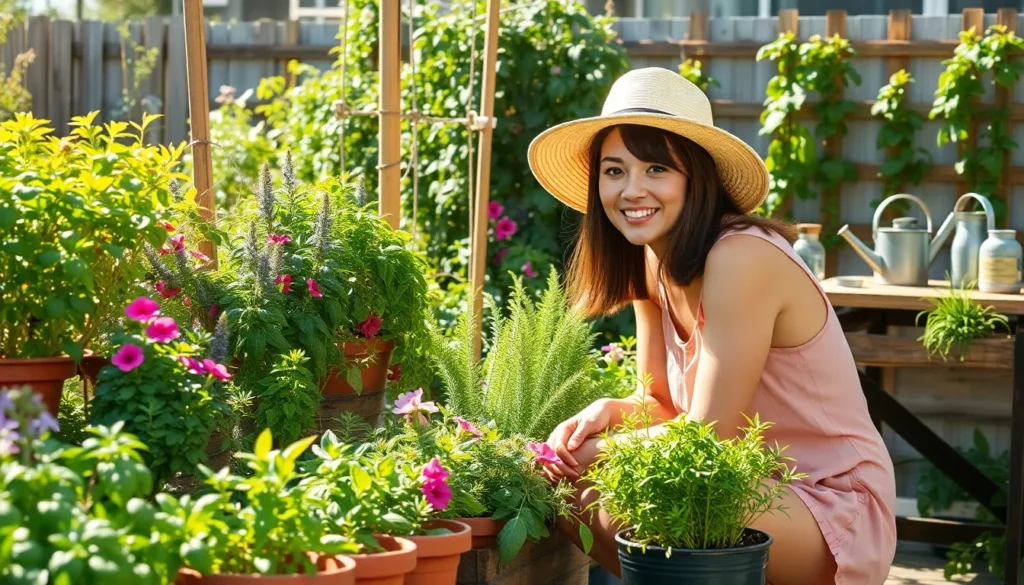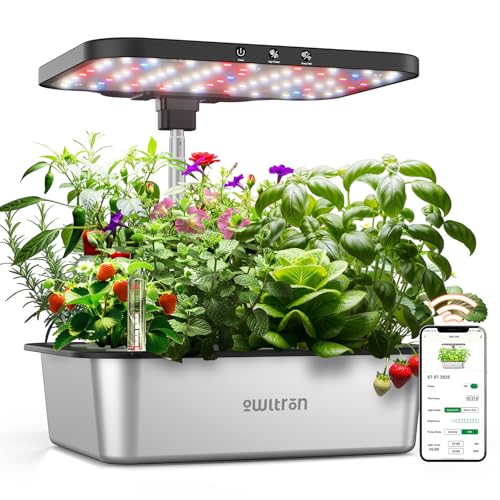Nothing beats the satisfaction of stepping outside and snipping fresh basil for tonight’s pasta or grabbing fragrant rosemary for Sunday’s roast. We’ve all dreamed of having our own herb garden, but many of us think we need acres of space or a green thumb to make it happen.
The truth is, you don’t need much room or experience to grow your own herbs. Whether you’ve got a sprawling backyard, a tiny balcony, or just a sunny windowsill, there’s an herb garden solution that’ll work for your space and lifestyle. From vertical wall gardens to repurposed containers, the possibilities are endless.
We’re here to show you that growing herbs isn’t just possible – it’s easier than you think. With the right approach, you’ll be harvesting fresh herbs year-round while saving money on those expensive grocery store packages that always seem to wilt before you can use them all.
Choose the Perfect Location for Your Herb Garden
Location determines whether your herbs will thrive or merely survive in your garden space. We’ll guide you through the essential factors that make the difference between a flourishing herb sanctuary and a disappointing growing experience.
Assess Sunlight Requirements
Sun exposure ranks as the most critical factor when selecting your herb garden location. Mediterranean herbs like rosemary, thyme, oregano, and lavender demand 6-8 hours of direct sunlight daily to develop their signature flavors and essential oils.
Observe your potential garden spots throughout different times of day to map sun patterns accurately. Morning sun from 8 AM to 2 PM provides the most beneficial light for herb photosynthesis and growth.
Partial shade herbs include mint, parsley, cilantro, and chives which tolerate 3-4 hours of direct sunlight per day. These varieties actually prefer some afternoon shade in hot climates to prevent wilting and bolting.
South facing locations typically receive the most consistent sunlight throughout the growing season. East facing spots work well for herbs that benefit from morning sun but need protection from intense afternoon heat.
Consider Water Access and Drainage
Water accessibility shapes your daily herb garden maintenance routine significantly. Position your herb garden within 50 feet of a water source to make regular watering manageable and sustainable.
Drainage prevents root rot which kills herbs faster than drought conditions. Test drainage by digging a 12 inch hole and filling it with water. Water should drain within 24 hours for optimal herb growing conditions.
Raised beds solve drainage problems in clay soil or low lying areas prone to water accumulation. Build beds 6-8 inches high using untreated cedar or composite materials for best results.
Slope considerations matter when natural drainage is poor. Create a gentle 2% grade away from buildings and toward natural drainage areas to prevent standing water around herb roots.
Evaluate Space Constraints
Vertical growing maximizes small spaces effectively for apartment dwellers and urban gardeners. Wall mounted planters, trellises, and tiered containers can triple your growing capacity in compact areas.
Container gardening offers flexibility for renters or those with poor soil conditions. Use 12 inch diameter pots minimum for perennial herbs like rosemary and sage to accommodate root development.
Companion planting optimizes limited garden space by grouping herbs with similar water and light requirements. Plant basil near tomatoes, oregano beside peppers, and mint in separate containers to prevent spreading.
Traffic patterns affect herb accessibility for daily harvesting and maintenance. Place frequently used culinary herbs like basil, parsley, and chives closest to your kitchen entrance for convenient cooking integration.
Design a Traditional In-Ground Herb Garden
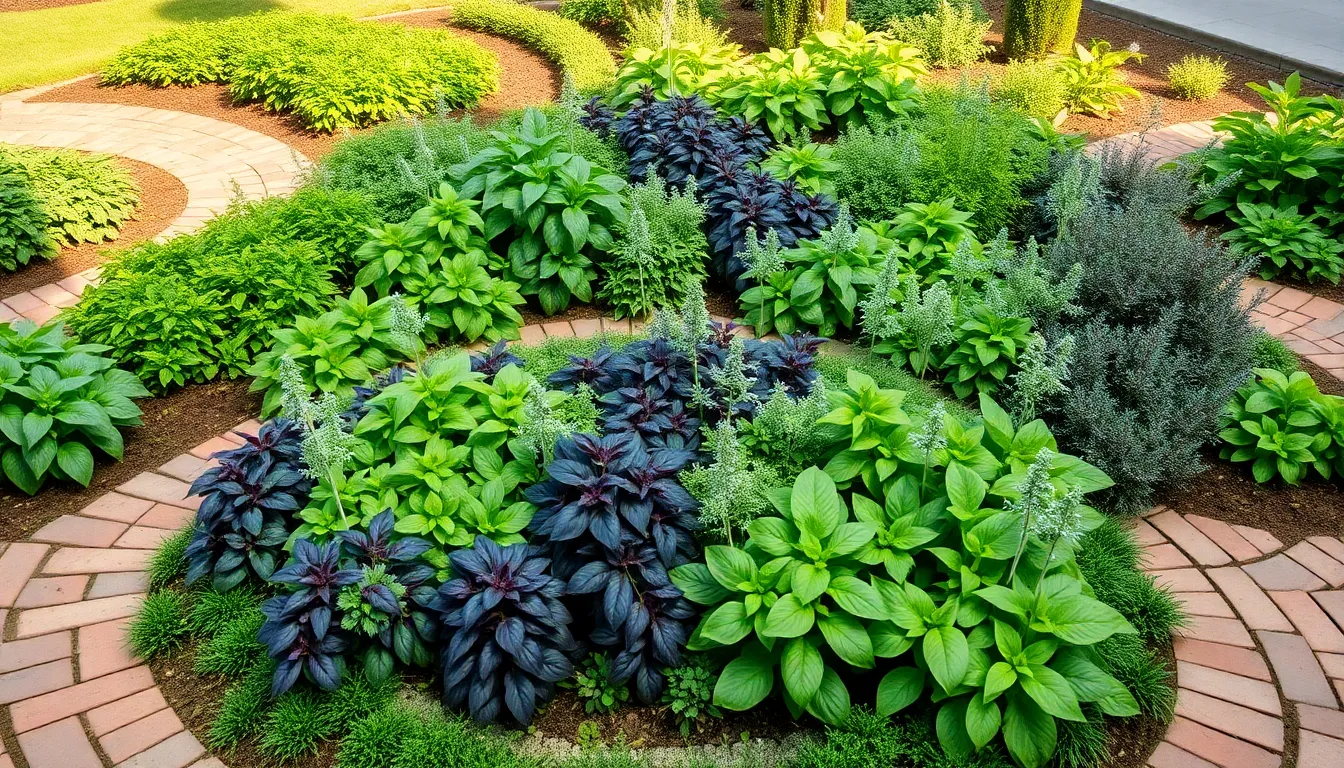
Traditional in-ground herb gardens bring timeless elegance to your outdoor space while maximizing growing potential. These gardens draw inspiration from medieval monastery designs that have proven successful for centuries.
Plan Your Garden Layout
Symmetrical layouts create the foundation of traditional herb garden design by dividing your space into balanced beds around a central focal point. We recommend measuring your available space and sketching a simple design that incorporates equal proportions on all sides.
Wheel patterns offer an attractive alternative that mimics the spokes of a cartwheel radiating from a center point. Position taller herbs like rosemary or sage near the center while placing shorter varieties such as thyme or oregano along the outer edges.
Chessboard designs provide another classic option by creating alternating squares of different herb varieties. This pattern works particularly well for gardens with 6 to 8 different herb types and creates natural visual separation between each variety.
Accessibility pathways ensure you can reach every herb without stepping on planted areas. Install stepping stones or create narrow walkways between beds using materials like gravel, mulch, or brick pavers spaced 18 to 24 inches apart.
Select Complementary Herb Varieties
Essential culinary herbs form the backbone of any traditional herb garden and should include basil, parsley, rosemary, and thyme for daily cooking needs. These four herbs provide the foundation for most Mediterranean and European cuisine preparations.
Medicinal varieties like chamomile, lavender, and mint add therapeutic value while contributing unique fragrances and textures to your garden design. Chamomile produces delicate white flowers that create beautiful contrast against darker foliage.
Contrasting leaf combinations enhance visual appeal by pairing herbs with different colors and textures throughout your design. Combine silver leafed sage with deep green basil or bright purple basil with golden oregano to create striking visual interest.
Height variations create depth and dimension by positioning taller herbs like fennel or dill as backdrop plants while using low growing varieties such as creeping thyme as border edging.
Prepare the Soil Properly
Well draining soil prevents root rot and ensures healthy herb growth by allowing excess water to flow away from plant roots. Test your drainage by digging a 12 inch hole and filling it with water to see how quickly it drains.
pH levels between 6.0 and 7.0 provide optimal growing conditions for most Mediterranean herbs like basil, oregano, and rosemary. Purchase a simple soil testing kit from your local garden center to determine your current pH levels.
Raised bed construction offers superior control over soil composition while improving accessibility for harvesting and maintenance tasks. Build beds 6 to 8 inches high using untreated cedar or composite materials for longevity.
Organic matter incorporation improves soil structure and provides slow release nutrients by mixing compost or aged manure into your existing soil. Add 2 to 3 inches of organic matter and work it into the top 8 inches of soil before planting.
Container barriers prevent aggressive spreaders like mint from taking over your entire garden by planting them in large buried pots with drainage holes. Choose containers at least 12 inches deep to accommodate root growth while maintaining containment.
Create a Container Herb Garden for Small Spaces
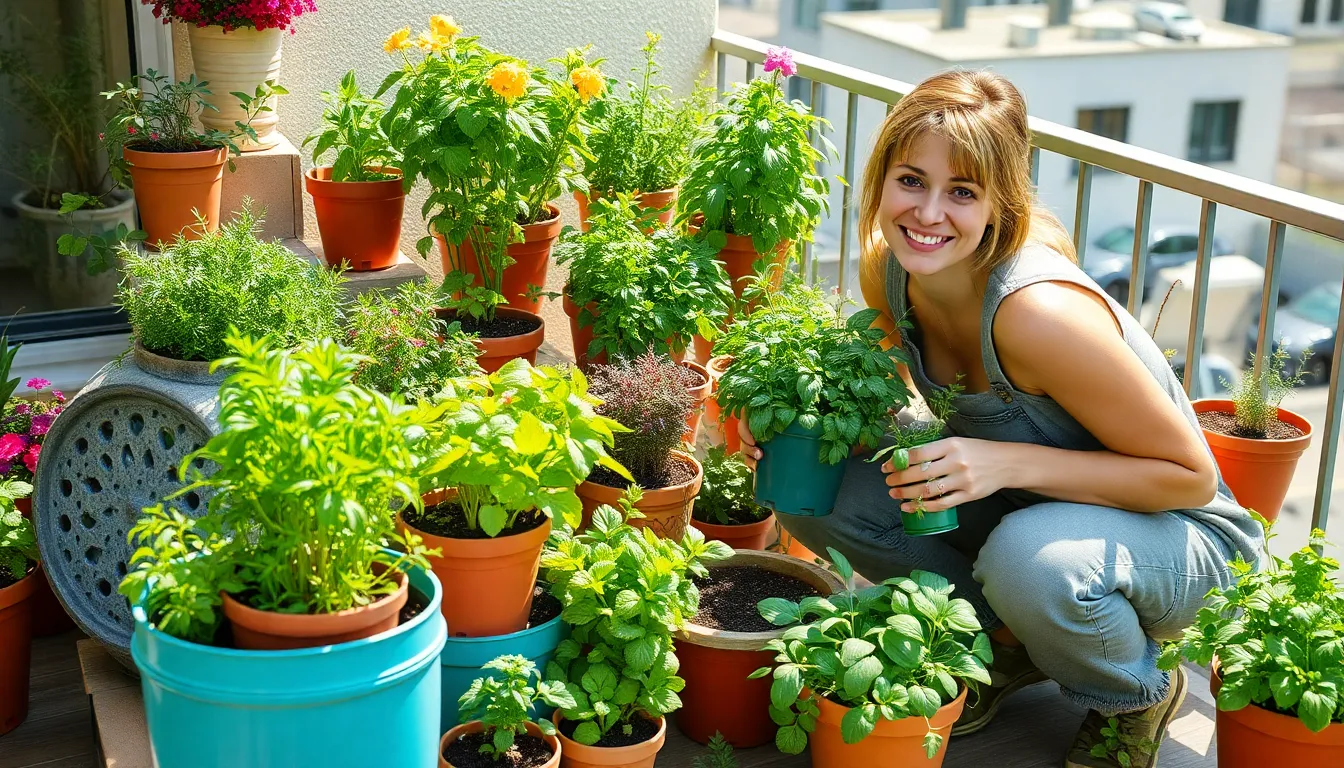
Container gardening transforms any small space into an herb growing paradise. We’ll guide you through essential steps to create your perfect container herb garden.
Choose the Right Containers
Selecting containers that are at least 6 inches deep provides adequate root space for healthy herb growth. Cedar containers offer natural pest resistance properties that protect your herbs from unwanted insects. Steel planters deliver exceptional durability for outdoor herb gardens that face harsh weather conditions.
Terra cotta clay pots remain the classic choice for their breathable walls that prevent root rot. Food grade materials ensure your culinary herbs stay safe for consumption without chemical contamination. Untreated containers support organic herb growth by avoiding harmful preservatives that can leach into soil.
Labeling becomes crucial when selecting containers for edible herb varieties. We recommend checking product descriptions for “food grade” and “untreated” certifications before purchasing. Recycled containers work well but require thorough cleaning and safety verification for growing edible plants.
Optimize Drainage Systems
Drainage holes prevent overwatering disasters that kill more container herbs than any other factor. Built in drainage systems allow excess water to escape naturally rather than pooling around delicate roots. Water trays collect overflow water while protecting surfaces from stains and damage.
Preventing messy overflows keeps your indoor growing areas clean and manageable. Elevated containers with drainage trays create airflow underneath pots that reduces fungal problems. Gravel layers at container bottoms enhance drainage capacity for herbs that prefer drier soil conditions.
Monitoring water levels becomes easier with clear drainage systems that show excess moisture. We suggest checking drainage efficiency by watering thoroughly and observing how quickly excess water flows out.
Arrange for Maximum Sun Exposure
Most herbs require 4 to 6 hours of direct sunlight daily for optimal growth and flavor development. South facing windows provide consistent light exposure throughout the day for indoor container gardens. Outdoor placement strategies include moving containers to follow sun patterns during different seasons.
Positioning containers in sunny spots maximizes photosynthesis that produces essential oils in culinary herbs. Italian oregano thrives in compact containers with full sun exposure while maintaining manageable growth habits. Greek oregano spreads aggressively and needs larger containers with careful pruning to prevent overcrowding.
Rotating containers weekly ensures even growth patterns that prevent herbs from leaning toward light sources. We recommend using plant caddies with wheels for easy container movement as seasons change sun angles.
Build a Vertical Herb Garden Wall
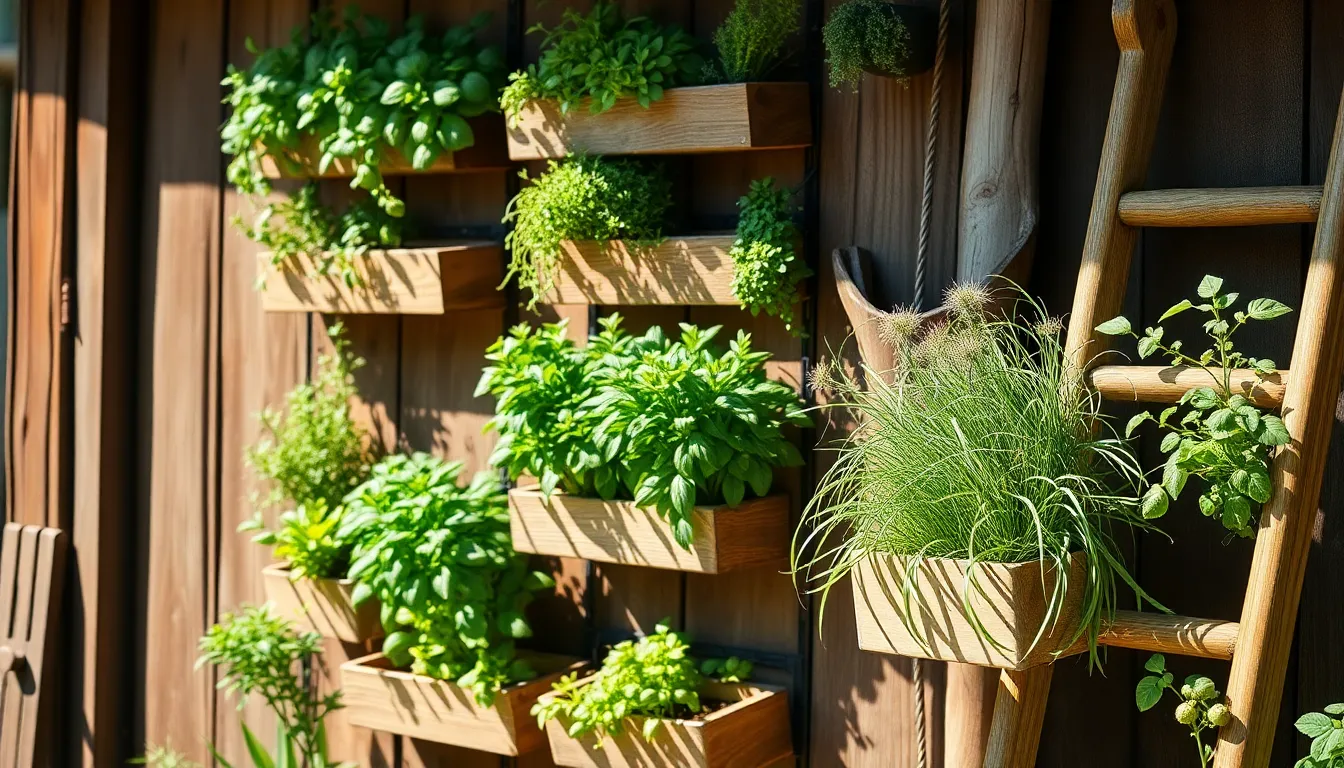
Wall mounted herb gardens transform any vertical surface into a productive growing space. We’ll show you how to maximize your herb production using three proven vertical gardening methods.
Install Wall-Mounted Planters
Wall mounted planters offer the most straightforward approach to vertical herb gardening. Wooden planters provide natural insulation for herb roots and blend seamlessly with outdoor decor, while plastic options deliver lightweight convenience for indoor installations.
Installation requires sturdy wall anchors rated for the combined weight of soil, water, and mature plants. We recommend spacing planters 18 inches apart vertically to allow adequate light penetration for lower tiers. Cedar and redwood planters resist moisture damage naturally, making them ideal for outdoor herb walls that face weather exposure.
Shallow rooted herbs like thyme, oregano, and chives thrive in wall mounted systems since they require only 6-8 inches of soil depth. These Mediterranean varieties also tolerate the faster drainage rates common in mounted planters, reducing maintenance while delivering consistent harvests.
Use Hanging Baskets Effectively
Hanging baskets maximize growing space by utilizing overhead areas often overlooked in traditional gardening. Select baskets with built in drainage holes to prevent waterlogged soil conditions that cause root rot in herb plants.
Placement strategy determines success with hanging herb gardens. We position baskets on south facing balconies and patios to capture 6-8 hours of direct sunlight required by most culinary herbs. Indoor installations work best near large windows or under grow lights providing equivalent light intensity.
Basket materials affect both plant health and maintenance requirements. Wire baskets lined with coconut fiber provide excellent drainage but require more frequent watering, while solid plastic containers retain moisture longer but need careful monitoring to prevent overwatering. Terra cotta offers the ideal balance of drainage and moisture retention for most herb varieties.
Create a Living Herb Ladder
Living herb ladders transform ordinary wooden ladders into functional vertical gardens perfect for small spaces. Wooden ladder systems accommodate multiple herb varieties on each rung while creating an attractive garden focal point.
Construction involves securing planters or containers to each ladder step using brackets or ties. We space containers 12-15 inches apart vertically to ensure each tier receives adequate sunlight. Recycled wooden ladders work excellently after treating with food safe wood preservatives.
Training climbing herbs like mint and lemongrass up ladder supports creates natural green walls. These vigorous growers require regular pruning to prevent overcrowding but reward gardeners with abundant harvests. Position ladders against sturdy walls or fences to provide stability as plants mature and add weight to the structure.
Establish a Window Box Herb Garden
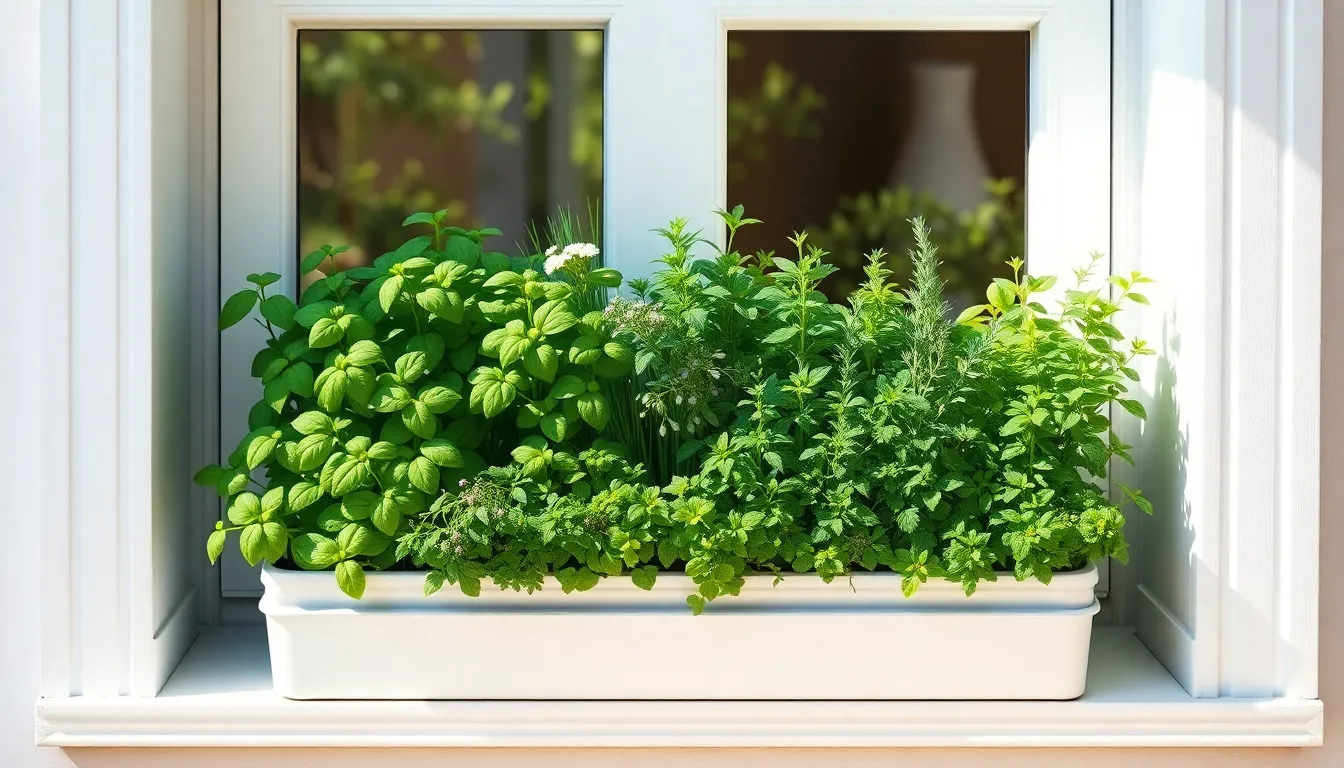
Window box herb gardens offer an excellent solution for growing fresh herbs when outdoor garden space is limited. We can create thriving herb gardens right outside our windows with proper planning and selection.
Select Appropriate Window Locations
Finding the right location starts with assessing sunlight exposure throughout the day. Most herbs require at least 6 hours of direct sunlight daily to produce their best flavors and essential oils. We should observe potential window locations from morning until evening to determine which spots receive consistent sun exposure.
South-facing windows typically provide the most reliable sunlight for herb growth. These locations capture morning sun and maintain brightness throughout the afternoon hours. East-facing windows work well for herbs that prefer morning sun with some afternoon shade protection.
Partial sunlight locations can still support certain herb varieties successfully. Herbs like mint, parsley, and cilantro thrive with just 3-4 hours of direct sunlight per day. We can use these spots for shade-tolerant varieties while reserving prime sunny locations for Mediterranean herbs.
Accessibility plays a crucial role in maintaining our window box herb garden. We should choose locations that allow easy reach for watering, harvesting, and general maintenance. Ground-floor windows or those accessible from balconies work best for regular care.
Choose Compact Herb Varieties
Compact herb varieties maximize growing space while providing abundant harvests. Dwarf thyme varieties reach only 6-8 inches in height and spread slowly, making them perfect for window box corners. These miniature versions produce the same intense flavors as their full-sized counterparts.
Oregano and sage offer excellent choices for contained growing environments. Compact oregano varieties like ‘Compactum’ stay under 10 inches tall and provide steady harvests throughout the growing season. Dwarf sage varieties produce aromatic leaves without overwhelming smaller containers.
Rosemary selections designed for containers prevent overcrowding issues. Varieties like ‘Blue Boy’ and ‘Spice Islands’ maintain manageable sizes while delivering the classic pine-like fragrance we love. These compact forms rarely exceed 12 inches in height and width.
Basil varieties bred for container growing ensure continuous leaf production. Bush basil types like ‘Spicy Globe’ form neat, rounded plants perfect for window box edges. These varieties produce small leaves ideal for frequent harvesting without compromising plant health.
Chives and parsley provide reliable options for beginners. Both herbs adapt well to container restrictions and tolerate various growing conditions. We can harvest these herbs repeatedly by cutting outer leaves while allowing centers to continue growing.
Maintain Proper Watering Schedule
Checking soil moisture prevents both overwatering and drought stress. We should test the top inch of soil with our finger before watering each time. Dry soil at this depth indicates it’s time to water thoroughly until drainage occurs.
Watering frequency typically occurs every other day during active growing seasons. Hot weather and increased plant growth require more frequent attention to soil moisture levels. We may need daily watering during peak summer months depending on our climate conditions.
Drainage systems prevent root rot and other moisture-related problems. Window boxes must include adequate drainage holes to allow excess water to escape freely. We can add a layer of gravel at the bottom to improve drainage in boxes without sufficient holes.
Morning watering schedules support optimal plant health and growth. Early watering allows herbs to absorb moisture before daily heat stress begins. This timing also prevents fungal diseases that develop when leaves remain wet overnight.
Quality potting soil with organic matter retains appropriate moisture levels. Well-draining potting mixes enriched with compost provide the ideal growing medium for window box herbs. We should avoid garden soil, which becomes too heavy and poorly draining in containers.
Develop a Kitchen Herb Garden for Easy Access
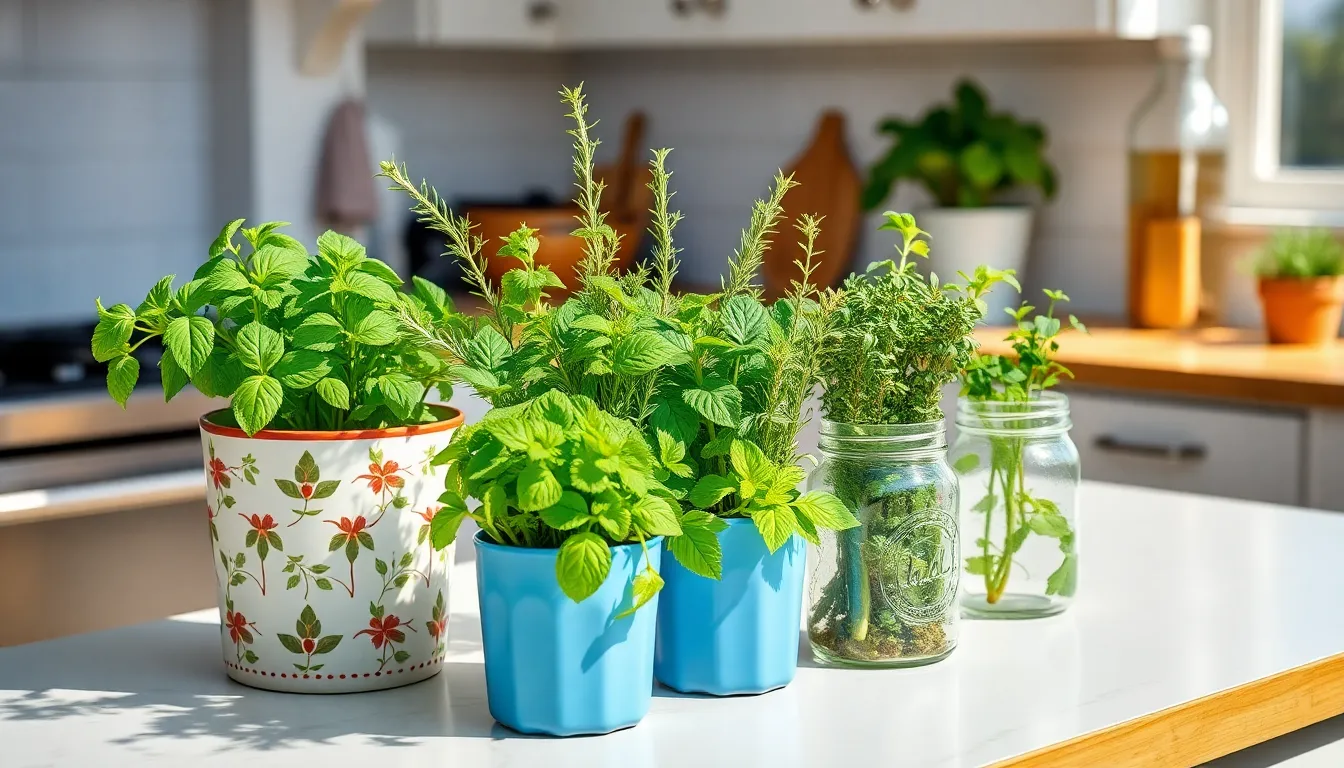
Creating a kitchen herb garden transforms your cooking experience by putting fresh flavors just steps away from your stove. We’ll explore strategic placement methods and essential herb selections that make culinary herb gardening both practical and rewarding.
Position Near Cooking Areas
Kitchen windows offer the most convenient location for growing herbs, allowing you to harvest basil while your pasta sauce simmers. Placing herbs within arm’s reach of your cooking areas means you’ll actually use them instead of letting store-bought packages wilt in your refrigerator.
Outdoor kitchen spaces provide excellent opportunities for larger herb collections, especially when you position them adjacent to grilling stations or prep areas. Consider installing raised beds or container gardens just outside your kitchen door for quick access during meal preparation.
Countertop herb gardens work perfectly for compact spaces, using mason jars or small pots that sit directly on your kitchen counter. Mount magnetic containers on your refrigerator to keep frequently used herbs like oregano and thyme within easy reach while cooking.
Focus on Culinary Essentials
Basil deserves top priority in any kitchen garden since it’s essential for pesto, Italian dishes, and fresh caprese salads. Plant multiple varieties like sweet basil, purple basil, and Thai basil to expand your culinary repertoire throughout the growing season.
Rosemary provides year-round flavor for roasted meats and vegetables, making it an invaluable addition to your herb collection. This hardy perennial thrives in containers and requires minimal maintenance once established in your kitchen garden.
Thyme enhances soups, stews, and sauces with its earthy flavor profile, while its compact growth habit makes it perfect for small kitchen gardens. Choose between common thyme for cooking and lemon thyme for more delicate fish dishes.
Mint offers versatility for teas, salads, and desserts, though we recommend containing it in separate pots to prevent it from overtaking other herbs. Plant spearmint for mojitos and peppermint for soothing teas to maximize your culinary options.
Ensure Year-Round Accessibility
Indoor herb gardens guarantee fresh herbs regardless of weather conditions, utilizing window sills, hanging baskets, or vertical wall planters for continuous harvests. Position these gardens near south-facing windows to provide the 6-8 hours of sunlight that Mediterranean herbs require for optimal growth.
Container systems allow you to move marginally hardy herbs indoors during harsh weather, protecting valuable plants like rosemary and oregano from winter damage. Use containers that are at least 6 inches deep with proper drainage holes to maintain healthy root systems year-round.
Seasonal rotation strategies ensure constant herb availability by starting new plants every few weeks and moving containers between indoor and outdoor locations. Plan succession plantings of fast-growing herbs like cilantro and dill to maintain fresh supplies throughout changing seasons.
Construct a Raised Bed Herb Garden
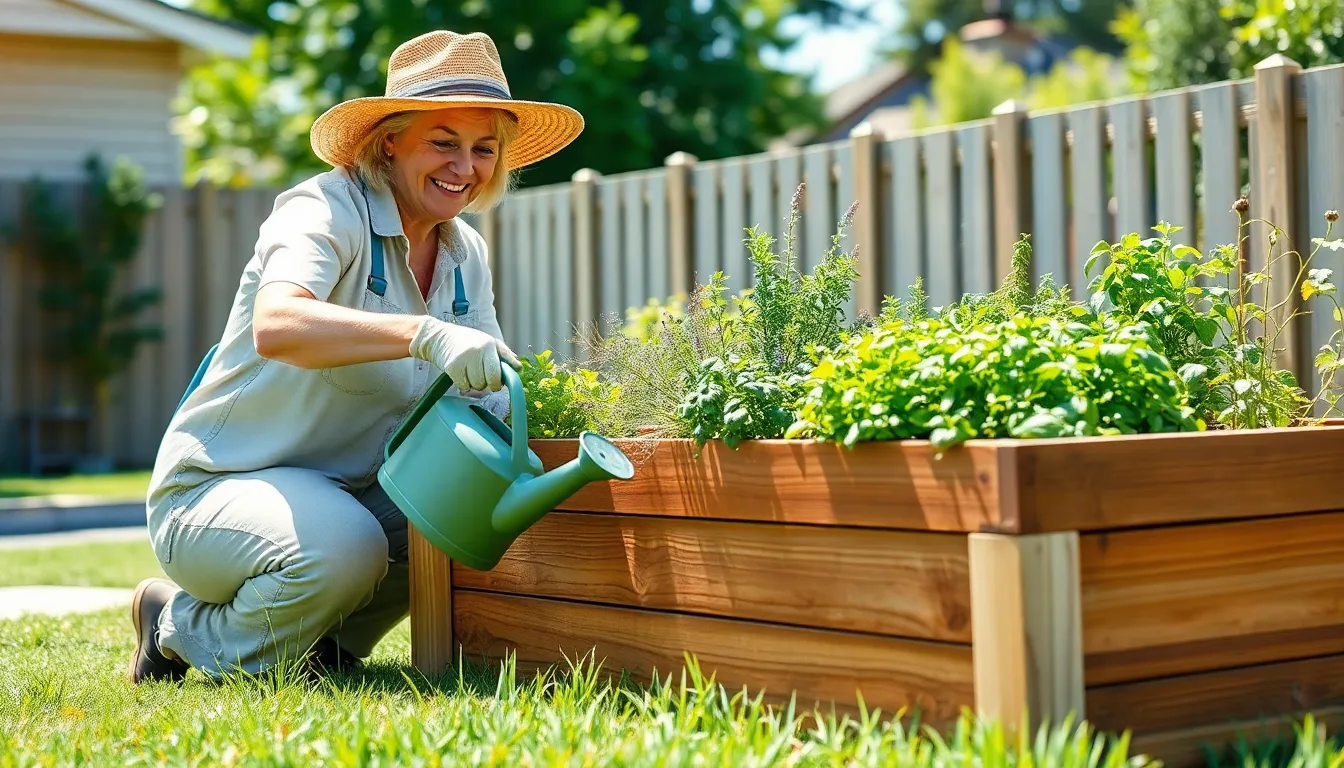
Raised bed gardens offer superior drainage control and easier maintenance compared to traditional ground planting. We’ll guide you through building the perfect elevated herb garden that delivers years of fresh harvests.
Build the Perfect Height and Size
Height selection depends on your accessibility needs and the herbs you’re growing. For most herb varieties, we recommend building beds between 6 and 24 inches tall, with 6 to 12 inches providing adequate root depth for herbs like basil, parsley, and oregano. Gardeners with mobility concerns benefit from taller beds around 18 to 24 inches, which reduce bending and strain during planting and harvesting.
Width determines how easily you can reach all areas of your garden. We suggest limiting bed width to 3 to 4 feet maximum, allowing comfortable access from both sides without stepping into the growing area. This dimension prevents soil compaction and protects delicate herb root systems from foot traffic.
Fill with Quality Growing Medium
Soil composition directly impacts herb growth and flavor development. We recommend creating a nutrient rich blend using 50% quality topsoil, 30% aged compost, and 20% peat moss for optimal drainage and fertility. This mixture provides the well draining environment most herbs require while supplying essential nutrients throughout the growing season.
Organic matter improves soil structure and water retention. Compost adds beneficial microorganisms that support healthy root development in herbs like rosemary, thyme, and sage. The peat moss component helps maintain consistent moisture levels without creating waterlogged conditions that can damage herb plants.
Design for Easy Maintenance
Strategic placement reduces daily garden management tasks. Position your raised bed within easy reach of your kitchen, ideally no more than 20 to 30 steps from your cooking area for convenient harvesting during meal preparation. Select a location receiving at least 6 hours of direct sunlight daily for Mediterranean herbs like basil and oregano.
Maintenance scheduling keeps herbs productive throughout the season. Check soil moisture levels every 2 to 3 days, watering when the top inch feels dry to the touch. Apply water soluble fertilizer every 4 to 6 weeks during the growing season to maintain steady nutrient availability for continuous herb production.
Weed prevention saves time and protects herb growth. Install industry fabric with drainage holes before adding your soil mixture to block weed emergence while allowing proper water flow. This barrier reduces manual weeding by up to 80% compared to beds without fabric protection, letting you focus on harvesting rather than maintenance.
Plant a Themed Herb Garden Collection
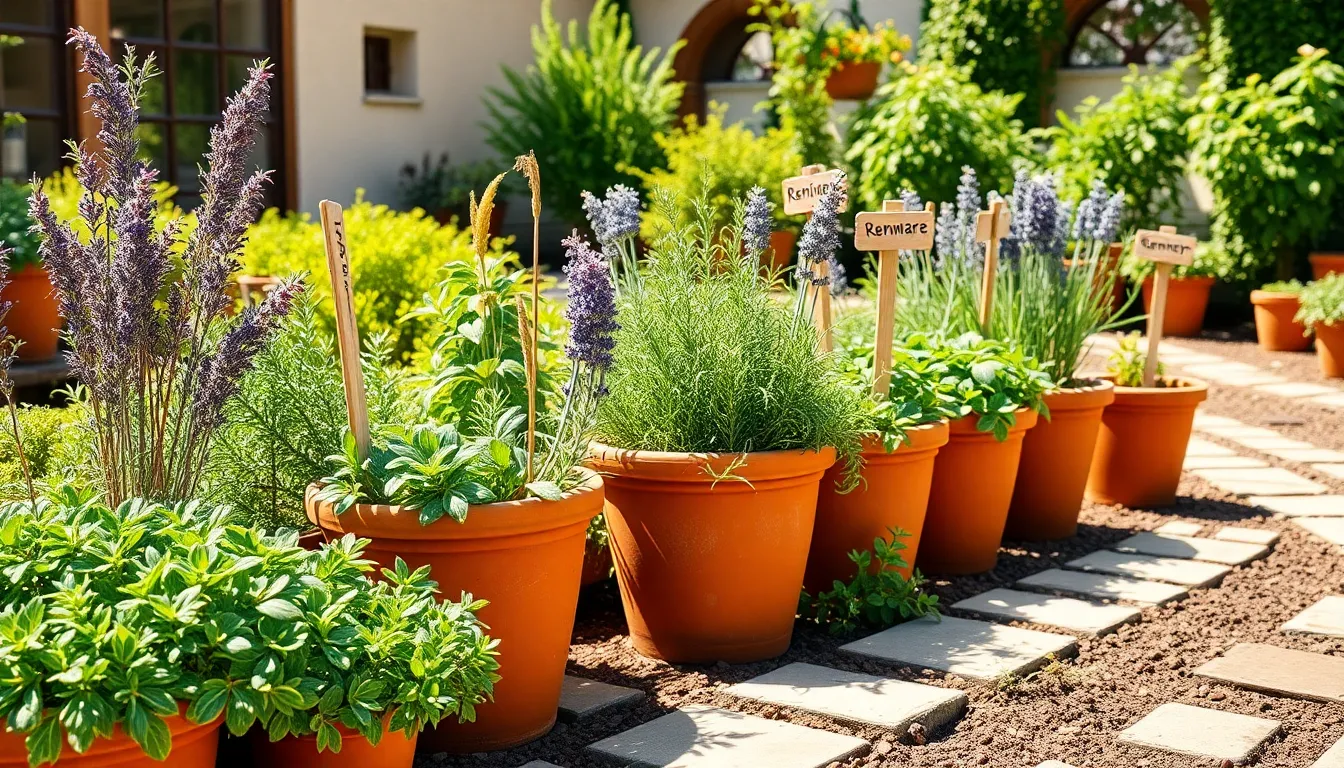
Themed herb gardens allow us to create focused collections that serve exact purposes while adding visual cohesion to our outdoor spaces. We can design these specialized gardens around particular cuisines, therapeutic uses, or beverage preferences.
Create a Mediterranean Herb Selection
Mediterranean herbs thrive in our gardens when we provide them with well-draining soil and plenty of sunshine. Rosemary serves as an excellent foundation plant with its woody stems and needle-like leaves that release aromatic oils when touched. Thyme spreads beautifully as ground cover while providing intense flavor for roasted vegetables and grilled meats.
Oregano delivers the authentic taste we need for pizza sauces and Greek dishes, growing vigorously in containers or directly in garden beds. Lavender adds both fragrance and edible flowers to our Mediterranean collection, attracting beneficial pollinators while deterring unwanted insects.
These herbs naturally complement each other in both growing conditions and culinary applications. We can arrange them in traditional terra cotta pots or stone planters to enhance the Mediterranean aesthetic throughout our garden space.
Design a Tea Herb Garden
Tea herb gardens offer us the opportunity to cultivate our own soothing beverage ingredients right outside our kitchen door. Lemon balm grows readily in partial shade and provides citrusy leaves perfect for evening relaxation teas.
Chamomile produces delicate daisy-like flowers that we can harvest and dry for calming bedtime brews. Peppermint spreads enthusiastically and should be contained in separate pots to prevent it from overtaking other herbs in our collection.
Lemon verbena creates refreshing tisanes with its intensely fragrant leaves that maintain their potency even after drying. We can design this garden with winding paths between herb clusters, creating a peaceful atmosphere that encourages meditation and reflection.
Wooden plant markers and vintage watering cans enhance the tranquil feeling while keeping our tea herbs organized and easily accessible for daily harvesting.
Establish a Medicinal Herb Plot
Medicinal herb gardens require careful planning and research to ensure we grow plants safely and effectively for health purposes. Calendula provides bright orange and yellow flowers that we can harvest for skin-soothing salves and healing balms.
Ginger thrives in containers where we can control soil moisture levels, offering fresh roots for digestive teas and cooking applications. Echinacea produces beautiful purple cone flowers while supporting our immune system when properly prepared and used.
Sage offers cognitive health benefits through its aromatic leaves that we can dry for teas or use fresh in culinary preparations. We should research proper dosages and preparation methods before using any medicinal herbs for health purposes.
Creating dedicated sections for each medicinal plant helps us track growing conditions and harvest times more effectively. Stone or brick pathways between planting areas provide easy access while preventing soil compaction around sensitive root systems.
Start an Indoor Herb Garden System
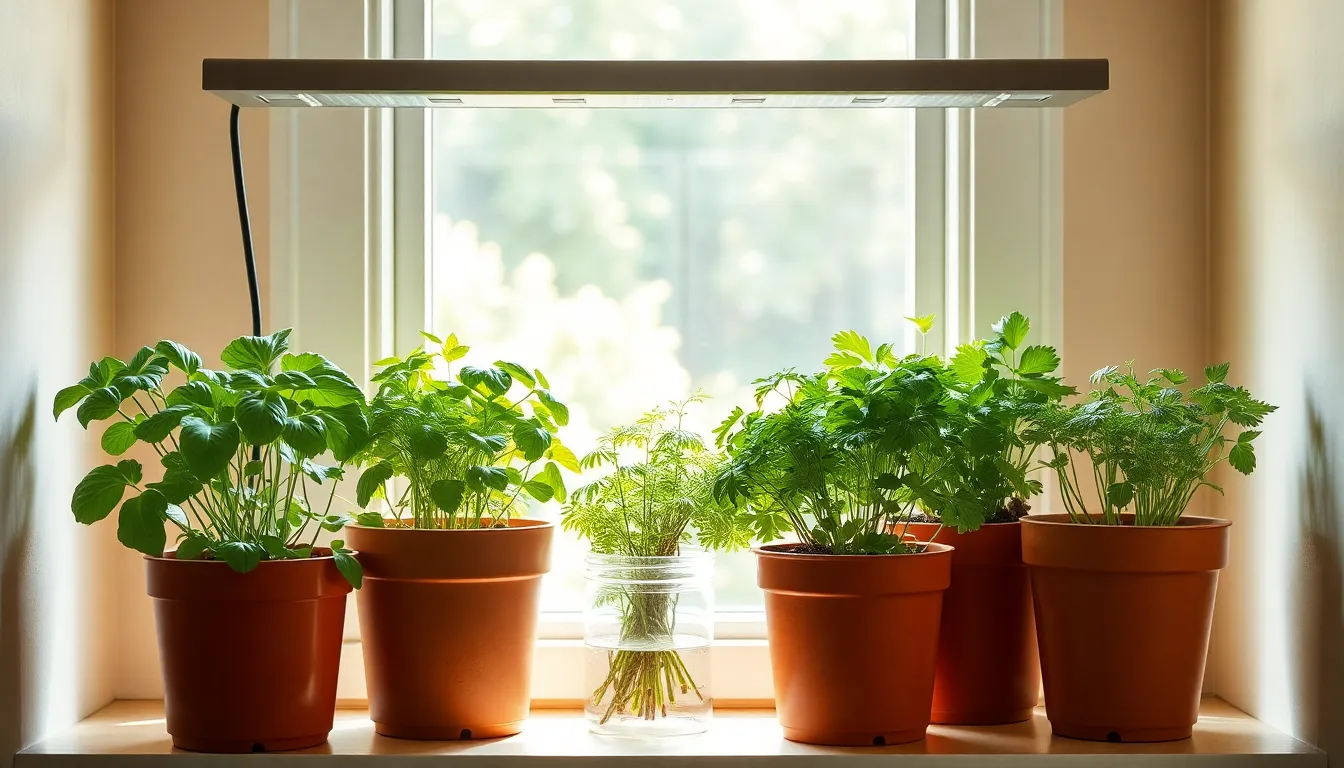
Indoor herb gardens bring fresh flavors to our kitchens year-round while requiring minimal space. We’ll establish a thriving indoor system by focusing on three essential components: proper lighting, environmental control, and plant selection.
Set Up Grow Lights
LED grow lights provide the most energy-efficient solution for our indoor herb gardens. We position these lights 6-12 inches above our plants to prevent leaf burning while ensuring adequate coverage. Running the lights for 12-14 hours daily mimics natural daylight conditions that herbs need for optimal growth.
South-facing windows offer the best natural light source, providing at least 6 hours of direct sunlight. But, we supplement with artificial lighting during shorter winter days or in rooms with limited natural illumination. Consider timer-controlled systems to maintain consistent lighting schedules without daily adjustments.
Control Temperature and Humidity
Maintaining temperatures between 65°F and 75°F creates ideal growing conditions for most herbs. We avoid placing our herb containers near heating vents or drafty windows that cause temperature fluctuations. Consistent temperatures promote steady growth and prevent stress-related issues like leaf drop or stunted development.
Moderate humidity levels support healthy herb growth without encouraging fungal problems. We can increase humidity by placing water-filled saucers near our plants or using a small humidifier in dry environments. Good air circulation prevents moisture buildup that leads to mold and mildew issues.
Choose Indoor-Friendly Varieties
Basil thrives indoors when we provide ample light and warmth, making it perfect for sunny windowsills. This aromatic herb requires more attention to lighting but rewards us with continuous harvests throughout the growing season.
Mint adapts well to partial shade conditions, allowing us to grow it in areas with less direct sunlight. We contain mint in separate pots since it spreads aggressively and can overtake other herbs.
Parsley and thyme tolerate lower light conditions better than most herbs, making them excellent choices for west-facing windows. These hardy varieties establish quickly and provide consistent harvests with minimal care requirements.
Design a Companion Planting Herb Garden
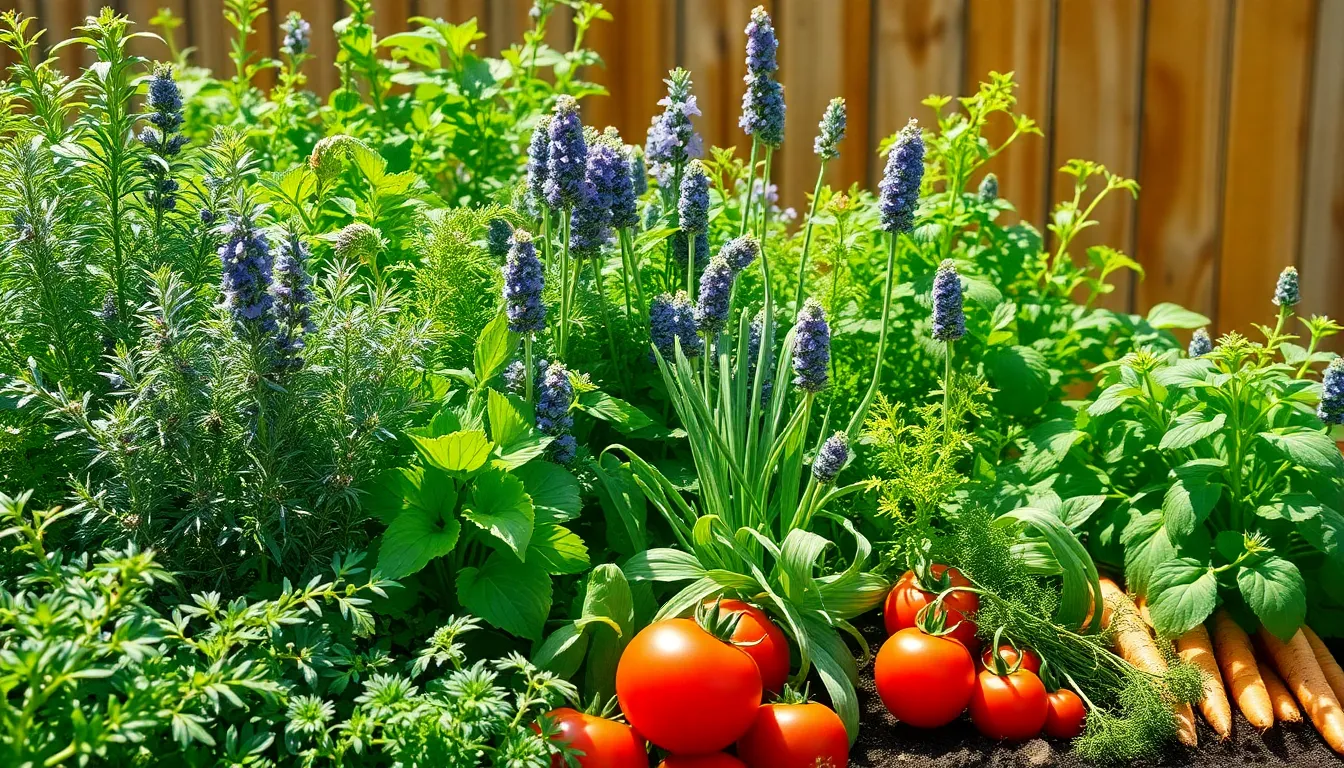
We’re transforming our herb garden into a thriving network where plants work together to enhance each other’s growth and flavor. This strategic approach maximizes space while creating natural partnerships that benefit both herbs and vegetables.
Pair Herbs with Vegetables
Basil and tomatoes create one of the most beneficial partnerships in companion planting, as basil enhances tomato flavor and scent while growing alongside them. We’ll position these plants together to take advantage of their complementary growth patterns and mutual benefits.
Rosemary paired with carrots improves carrot health and provides natural pest deterrence throughout the growing season. This combination works particularly well because rosemary’s woody structure doesn’t compete with carrot root development.
Chives alongside asparagus repel aphids and other harmful pests while allowing both plants to thrive in similar soil conditions. We recommend planting chives around asparagus crowns to create a protective barrier against common garden pests.
Parsley and chervil enjoy similar light and water conditions, making them perfect companions that enhance each other’s growth when planted together. These herbs share compatible root systems and growing requirements.
Use Natural Pest Control
Lavender serves as a natural deterrent against deer and rabbits, protecting our entire herb garden from these common garden visitors. We’ll strategically place lavender plants around the garden perimeter for maximum protection.
Thyme effectively repels cabbage worms and other destructive insects while adding aromatic value to our garden design. This hardy herb creates a natural barrier when planted near vulnerable vegetables.
Chives attract beneficial insects like ladybugs that consume harmful pests, creating a balanced network within our garden space. We’ll use chives as border plants to encourage these helpful predators throughout the growing area.
Sage and rosemary work together to deter various flying insects while thriving in similar dry growing conditions. These Mediterranean herbs create a fragrant defense system when planted in clusters.
Maximize Garden Productivity
Compatible sunlight requirements ensure all our companion plants receive adequate light exposure without competing for resources. We’ll group herbs and vegetables with similar needs for 6-8 hours of direct sunlight in designated areas.
Matching water requirements prevent over or under watering issues while maintaining optimal growing conditions for all plants. Rosemary, thyme, lavender, and sage prefer well-drained soil and can thrive together in drier sections.
Different root depths reduce competition between plants like chives and rosemary, allowing both to access nutrients at various soil levels. We’ll pair shallow rooted herbs with deeper rooted varieties to maximize space efficiency.
Compatible growth rates prevent faster growing plants from overcrowding slower developing varieties in our companion planting design. Strategic spacing between aggressive spreaders like mint and compact herbs maintains garden balance throughout the season.
Conclusion
Whether you’re drawn to a simple windowsill setup or an elaborate outdoor Mediterranean collection your herb garden journey starts with taking that first step. We’ve shown you that successful herb gardening doesn’t require years of experience or expensive equipment – just the right knowledge and a willingness to experiment.
The beauty of growing herbs lies in their versatility and forgiving nature. From companion planting strategies that boost your vegetable garden to therapeutic tea blends that create moments of calm these fragrant plants offer rewards that extend far beyond the kitchen.
Your herb garden will evolve as you discover which varieties thrive in your space and which flavors become staples in your cooking. Start small choose plants that excite you and watch as your confidence grows alongside your herbs. Fresh homegrown flavor is closer than you think.
Frequently Asked Questions
Can I grow herbs without a large garden space?
Absolutely! You can grow herbs in small spaces using vertical gardens, containers, or repurposed items. Options include hanging planters, window boxes, or even indoor herb gardens. With creative solutions like these, anyone can enjoy fresh herbs regardless of their living situation or available outdoor space.
How much sunlight do herbs need to grow properly?
Most Mediterranean herbs like rosemary, thyme, and oregano require 6-8 hours of direct sunlight daily. However, herbs that prefer partial shade, such as parsley and chives, thrive with just 3-4 hours of sunlight. Position your herb garden accordingly based on the specific varieties you choose to grow.
What are the essential herbs for beginners to start with?
Start with easy-to-grow culinary herbs like basil, parsley, rosemary, and thyme. These foundational herbs are versatile in cooking, relatively low-maintenance, and adapt well to various growing conditions. They provide excellent value and encourage continued herb gardening success for beginners.
How do I prepare soil for an in-ground herb garden?
Ensure good drainage by adding organic matter like compost to heavy soils. Test your soil’s pH level, as most herbs prefer slightly alkaline conditions. Incorporate compost or well-aged manure to improve soil structure and fertility. Proper drainage is crucial to prevent root rot in herb plants.
Can I grow herbs indoors year-round?
Yes! Indoor herb gardens allow fresh flavors year-round with minimal space. Use LED grow lights positioned 12-18 inches above plants for 12-16 hours daily. Maintain temperatures between 65-75°F and moderate humidity. Choose indoor-friendly varieties like basil, mint, parsley, and thyme for best results.
What is companion planting with herbs?
Companion planting strategically pairs herbs with vegetables to enhance growth and flavor while deterring pests. Examples include basil with tomatoes, rosemary with carrots, and chives with asparagus. This method maximizes garden productivity and creates natural pest control while optimizing space usage.
How do I prevent aggressive herbs from taking over my garden?
Use container barriers for spreading herbs like mint to prevent them from overtaking other plants. Plant aggressive herbs in buried pots or separate containers within your garden bed. This containment method allows you to enjoy these herbs while protecting neighboring plants from being crowded out.
What are the benefits of creating themed herb gardens?
Themed gardens like Mediterranean, tea, or medicinal collections allow specialized growing conditions and focused culinary uses. Plants in themed gardens typically share similar care requirements, making maintenance easier. They also create cohesive garden designs and provide specific benefits for cooking, relaxation, or wellness purposes.

